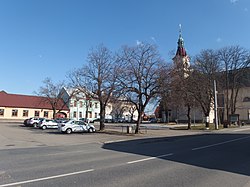Lanžhot (German: Landshut) is a town in Břeclav District in the South Moravian Region of the Czech Republic. It has about 3,600 inhabitants. Located on the border with Austria and Slovakia, it is the southernmost Moravian town.
Lanžhot | |
|---|---|
 Town square | |
| Coordinates: 48°43′28″N 16°58′0″E / 48.72444°N 16.96667°E | |
| Country | |
| Region | South Moravian |
| District | Břeclav |
| First mentioned | 1384 |
| Government | |
| • Mayor | Ladislav Straka |
| Area | |
| • Total | 54.83 km2 (21.17 sq mi) |
| Elevation | 164 m (538 ft) |
| Population (2024-01-01)[1] | |
| • Total | 3,627 |
| • Density | 66/km2 (170/sq mi) |
| Time zone | UTC+1 (CET) |
| • Summer (DST) | UTC+2 (CEST) |
| Postal code | 691 51 |
| Website | www |
Etymology
editThe original Latin name Lanczhut and the German name Landshut meant 'land guard', referring to its location on the border between Austria and Kingdom of Hungary. The Czech name is transcription of the original name.[2]
Geography
editLanžhot is located about 7 kilometres (4 mi) southeast of Břeclav and 56 km (35 mi) southeast of Brno. It lies in the Lower Morava Valley. The municipal territory is located on the border with Austria and Slovakia.
The eastern border (with Slovakia) is formed by the Morava River and the western border (with Austria) is partly formed by the Thaya River. Their confluence forms the tripoint of the Czech Republic, Austria and Slovakia. Other notable watercourses in Lanžhot are the Kyjovka River (which joins the Thaya on the Czech-Austrian border) and the Svodnice Stream (which joins the Kyjovka near the town proper).
The area of the confluence of the Morava and Thaya, which also includes many pools, oxbow lakes and channels, is the most valuable ichthyological site in the country. About 80% of native Czech fish species can be found there, and 15% of them live only there.[3]
History
editThe first written mention of Lanžhot is from 1384.[2]
Demographics
edit
|
|
| ||||||||||||||||||||||||||||||||||||||||||||||||||||||
| Source: Censuses[4][5] | ||||||||||||||||||||||||||||||||||||||||||||||||||||||||
Transport
editThe D2 motorway passes through Lanžhot. On the Czech-Slovak border are two road border crossings and one rail border crossing.
Sights
editLanžhot is poor in monuments. The only protected cultural monuments are two homesteads from the second half of the 20th century and a statue of a Red Army soldier from 1953.[6]
The main landmark is the Church of the Exaltation of the Holy Cross. There was an old church, which was completely rebuilt in 1893. Only the sacristy, the chancel and the ascent to the bell tower remained from the old church.[7]
Notable people
edit- Edmund von Krieghammer (1832–1906), Austrian general
- Antonín Bartoš (1910–1998), soldier and resistance fighter
Twin towns – sister cities
edit- Rabensburg, Austria
References
edit- ^ "Population of Municipalities – 1 January 2024". Czech Statistical Office. 2024-05-17.
- ^ a b "Historie Lanžhota" (in Czech). Město Lanžhot. Retrieved 2021-11-24.
- ^ "Druhové bohatství" (in Czech). Nature Conservation Agency of the Czech Republic. Retrieved 2024-09-19.
- ^ "Historický lexikon obcí České republiky 1869–2011" (in Czech). Czech Statistical Office. 2015-12-21.
- ^ "Population Census 2021: Population by sex". Public Database. Czech Statistical Office. 2021-03-27.
- ^ "Výsledky vyhledávání: Kulturní památky, obec Lanžhot". Ústřední seznam kulturních památek (in Czech). National Heritage Institute. Retrieved 2024-08-27.
- ^ "Kostel Povýšení sv. Kříže" (in Czech). Město Lanžhot. Retrieved 2023-06-21.
- ^ "Rabensburg – naše partnerská obec" (in Czech). Město Lanžhot. Retrieved 2021-11-24.


